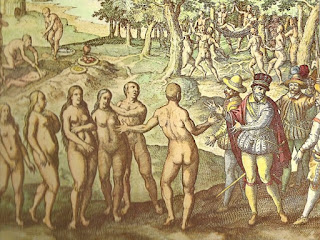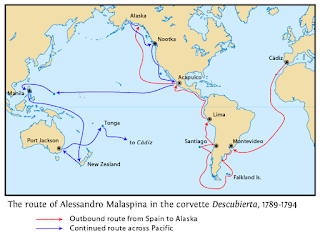Medici clerk who discovered a new world
 |
| Amerigo Vespucci began exploring as an observer at the invitation of the King of Portugal |
Explorer and cartographer Amerigo Vespucci was born on this
day in 1454 in Florence.
Vespucci was the first to discover the ‘new world’, which
later came to be called the Americas, taking the Latin version of his first
name.
He was the son of a notary in Florence and a cousin of the
husband of the beautiful artist’s model, Simonetta Vespucci. He was educated by
his uncle, Fra Giorgio Antonio Vespucci, a Dominican friar, and he was later
hired as a clerk by the Medici family.
He acquired the favour of Lorenzo di Pierfrancesco de' Medici, who sent him to the Medici office in Cadiz in Spain to investigate the
managers, who were under suspicion.
Later, as the executor of an Italian merchant who had died
in Seville, Vespucci fulfilled the deceased’s contract with Castile to provide
12 vessels to sail to the Indies. He then continued supplying provisions for
expeditions to the Indies and was invited by the King of Portugal to
participate as an observer on several voyages of exploration.
Although letters have been forged and fraudulent claims have
been made about his discoveries, Vespucci is known to have taken an active part
in at least two real voyages of exploration.
 |
| Vespucci's arrival in the 'new world', as imagined by the Flemish engraver Theodor de Bry |
In 1499, on a voyage intended to round the southern end of
the African mainland into the Indian ocean, Vespucci is believed to have crossed
the Atlantic, hitting land in what is now Guyana on the South American
mainland, then sailed southwards, discovering the mouth of the Amazon river and
seeing Trinidad and the Orinoco river, before returning to Spain.
In 1501, he was on a voyage which reached the coast of
Brazil and sailed along the coast of South America to Rio di Janeiro’s bay. He
wrote in a letter to Lorenzo di Pierfrancesco de' Medici that the land masses
were ‘larger and different from the Asia described by Marco Polo and,
therefore, must be a new world, a previously unknown fourth continent.’
In 1507, an author of a geography book, Martin
Waldseemüller, suggested the name America, especially for the Brazilian part of
the new world, in honour of the ‘illustrious man’ who discovered it. This is
how the names for North America and South America originated.
Vespucci was made chief navigator of Spain in 1508 by King
Ferdinand and was commissioned to start a school of navigation, where he
developed a rudimentary method of determining longitude. He died in 1512 at his
home in Seville, aged 57.
| The church of San Salvatore di Ognissanti is the parish church of the Vespucci family |
Travel tip:
The parish church of the Vespucci family is the Church of
All Saints - Chiesa di San Salvatore di Ognissanti - in Borgo Ognissanti, close to
the Santa Maria Novella railway station. In the Vespucci Chapel, a fresco by
Domenico Ghirlandaio depicts the Madonna della Misericordia protecting members
of the Vespucci family. It is believed to show Amerigo Vespucci as a child
among them. Vespucci later named a bay in Brazil, San Salvatore di Ognissanti,
which is the origin of the name of the city of Salvador in Brazil.
Find a Florence hotel on TripAdvisor
Find a Florence hotel on TripAdvisor
 |
| The statue of Amerigo Vespucci by the Ufizzi |
Travel tip:
The Uffizi Gallery in Florence has a posthumous portrait of
Amerigo Vespucci, which has been attributed to Cristofano dell’Altissimo.
Outside the gallery there is also a statue of Amerigo Vespucci. The Uffizi is
one of the most important art galleries in the world and attracts so many
visitors it is vital to book a ticket in advance to avoid a long wait. The
complex of buildings that make up the gallery was designed by Giorgio Vasari as
offices - uffizi - for the Medici family in 1560.
More reading:
Why Simonetta Vespucci was seen as the embodiment of female perfection
Lorenzo di Pierfrancesco de' Medici - the art enthusiast who was Botticelli's patron
Created by an Italian - New York's monument to Christopher Columbus
Also on this day:
1809: The birth of statesman and Chianti wine 'inventor' Bettino Ricasoli
1908: The founding of football superpower Internazionale of Milan
1948: The birth of radical politician Emma Bonino
(Picture credit: Church of San Salvatore di Ognisanti by Sailko; statue by Jebulon)









